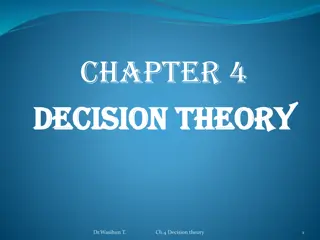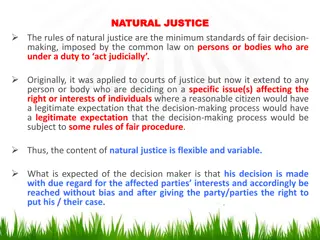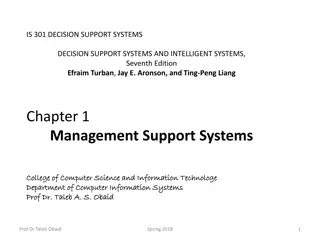Understanding Economic Systems and Decision Making
The chapter delves into different economic systems such as traditional, command, and market economies, exploring how each handles scarcity and decision-making. It discusses traditions in American society, essential vocabulary, advantages, and disadvantages of traditional economies, and the impact of growing up in such a system. Centralized authority in command economies is highlighted, where the government controls economic decisions. Through images and text, the significance of economic systems in societal survival is emphasized.
Download Presentation

Please find below an Image/Link to download the presentation.
The content on the website is provided AS IS for your information and personal use only. It may not be sold, licensed, or shared on other websites without obtaining consent from the author. Download presentation by click this link. If you encounter any issues during the download, it is possible that the publisher has removed the file from their server.
E N D
Presentation Transcript
Economic Systems and Decision Making Chapter 2 Bellringer: Describe some traditions that Americans follow in society. Essential Vocabulary: stagnation, emphasizing, traditional economy, economic systems, command economy, socialism, market, market economy, capitalism Essential Question: How do economic systems help deal with scarcity? Copy and complete the chart on page 38.
Economic Systems The survival of any society depends on its ability to provide food, clothing, and shelter for its people. All societies have something else in common. They have an economy or economy system an organized way of providing for the wants and needs of the people
Complete the chart Chapter 2, sec. 1 Economic System/define Example Advantages Disadvantages 1. 2. 3.
Economic Systems Traditional Command Market
Traditional The allocation of scarce resources, and nearly all other economic activity, stems from ritual, habit, or custom. Habit and custom also dictate most social behavior. Individuals are not free to make decisions based on what they want or would like to have. Instead, their roles are defined by customs of their elders and ancestors.
ADVANTAGES Everyone knows which role to play You produce what your family had always produced How the same way your parents did For Whom- determined by customs and traditions DISADVANTAGES -discourages new ideas and new ways of doing things
How would your life be different if you had grown up in a traditional economy?
Command Economics One in which a central authority makes most of the What, How, for Whom decisions. Economic decisions are made by the government: the people have little, if any , influence over how the basic economic questions are answered. (Pure Economy)
Socialism Economic system which government owns some factors of production, but not all, and has a role in determining what, how and for whom goods are produced
Pure Command Economies and Socialist Economies share a common trait the major economic decisions are made for the people, Not by them!
ADVANTAGES it can change directions drastically in a relatively short time Health and public services are available to everyone at little or no cost, regardless of income
DISADVANTAGES -it is not designed to meet the wants of consumers, even though many basic needs are provided. -the system does not give people incentive to work hard (receive similar wages regardless of skill) -Requires a large decision-making bureaucracy -Have high taxes to pay for offered services -People with new or unique ideas find it difficult to get ahead in a command economy
Market Economy Capitalism where private citizens own and use the factors of production for their on profit People and firms act in their own interests to answer the WHAT, HOW, AND WHOM questions. In a market economy, people s decisions act as votes.
Advantages Over time, it can adjust to change Its high degree of individual freedom producers may make whatever they think will sell Relatively small degree of government interference That decisions making is decentralized or not concentrated in the hands of a few Variety of goods and services available to consumers The high degree of consumer satisfaction
Disadvantages It does not provide for the basic needs of everyone in the society It does not provide enough of the services that people value highly (defense, education) so, the government must provide these services, paid for by tax dollars Relatively high degree of uncertainty that workers and businesses face as a result of change.
Foldable Activity Make a foldable on the three economic systems Include the following information How basic economic decisions made in each system Advantages and Disadvantages of each system Examples of Societies for each system
Lesson 1 Review Page 46 numbers 1-7
Mixed Economies Lesson 2 Bellringer: What do you think a mixed economy is? Essential Vocabulary: allocation, mixed economies, Great Depression, communism Essential Question: How do economic systems help society deal with scarcity? Copy and complete chart on page 48
Define Mixed Economy Advantages Disadvantages
Mixed Economies economic systems where tradition, command, and markets each answer some of the WHAT, HOW, and FOR WHOM questions.
Traits of a Mixed Economy The government controls large industries, while private individuals control small businesses. Citizens are taxed heavily to provide all citizens a social safety net such as welfare, free university tuition and free health care.
Cont. Property is controlled by both the government and private individuals. Workers tend to be somewhat less productive than those in market economies, but less product then those in command economies. Consumers generally have a wide variety choices.
Examples of a Mixed Economy In France health care is free, university costs very little if you get in (many do not) and taxes are high. However, there are also private industries based out of France like Air France and Peugeot. In United Kingdom health care is free, university is cheap, but citizens can purchase private health insurance and attend private universities if they choose. The United States is not totally a market economy. It is a mixed economy. Example 1: The economy of the United States is based on private enterprise. However, some industries (for example, power companies and railroads in some areas) are under collective ownership.
Criticism of Mixed Economies Criticism of Mixed Economies Mixed economies often suffer from higher unemployment rates and lack the same number of entrepreneurs as market economies. Mixed economies often must raise taxes in order to sustain all of the social services such as welfare, free health care, low cost university education and pension systems for the elderly which can lead to a stagnant economy. In essence, critics claim that mixed economies enable irresponsible behavior.
Which economic system is best? Which economic system is best? The market system has proven to be best because it promotes the goals of growth, freedom, & efficiency. Citizens are free to own their own property and use it in the most efficient and profitable way. Command and traditional systems sometimes offer more security but are not nearly as strong in efficiency, growth, freedom, and environmental quality.
Lesson 2 Review Page 53 numbers 1-6
Lesson 3 The Global Transition to Capitalism Bellringer: Why are some countries with command economies switching to capitalism? Essential Vocabulary: undertaking, isolationism, GDP per capita, privatization, vouchers, Five-Year Plan, Gosplan, collectivization, perestroika, Great Leap Forward, nationalization, Solidarity, European Union, black market, capital-intensive, keiretsu, population density Essential Question: How do economies help socities deal with scarcity? Copy and complete the chart on page 56.
Why Capitalism? Capitalism is the most powerful engine for generating wealth It has improved nearly everyone s standard of living
Problems of Transition Privatization the conversion of state owned factories and other property to private ownership -Important because people tend to take better care of something that they own -some countries used Vouchers-certificate used to buy government owned property Loss of Political Power Responding to new incentives Understanding the cost -Can be capital intensive- requiring a lot of investment and labor
Countries and Regions in Transition In Russia, there was once collectivism, the forced common ownership of the factors of production, but the decades-long transition to capitalism has resulted in the current market-based economy, with the exception of government-controlled energy, natural resource, and defense-related industries. In Europe, various countries came together to form the European Union to replace the European Coal and Steel Community and connect Europe into a single market After the failure of the Great Leap Forward, China was influenced by successful market economies in Asia and today is undergoing some privatization and other capitalistic endeavors.
Cont. In Latin America, socialism still exists in Venezuela and Argentina, but Chile has made the transition to capitalism. After the Soviet Union collapsed, many Eastern European countries transitioned to capitalism, including Poland, Hungary, the Czech Republic, and Slovakia. Compared to the U.S. government, the Japanese government is much more involved in the day-to-day activities of the private sector.
Cont. By opening its markets to world trade, South Korea has progressed from one of the poorest countries in Asia in the mid- 1950s to a leading producer of electronics and automobiles today. The government in Singapore has focused on a few select industries, pouring money and resources into pharmaceuticals, medical technology, and financial and high-tech industries. Taiwan has always depended on economic planning and was one of the early economic powers in Asia, but its centralized planning may hamper future economic growth.
Lesson 2 & 3 Activity Define: Mixed Economy and Communism What is a criticism of mixed economies? What are some problems faced when transitioning to capitalism? Complete the following chart How governments are involved in economy and promote growth Country Russia China Chile Japan South Korea
Assignment Page 65 numbers 1-6 Page 67-68 numbers 1-21.























